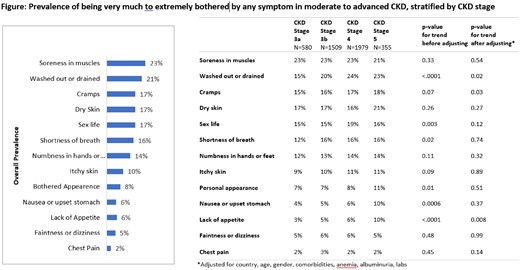-
PDF
- Split View
-
Views
-
Cite
Cite
Conor Walsh, Leonard Browne, Austin Stack, MO487
DYSNATRAEMIA AND ASSOCIATED MORTALITY RISK THRESHOLDS ARE MODIFIED BY KIDNEY FUNCTION IN THE IRISH HEALTH SYSTEM: THE NATIONAL KIDNEY DISEASE SURVEILLANCE SYSTEM (NKDSS), Nephrology Dialysis Transplantation, Volume 36, Issue Supplement_1, May 2021, gfab087.007, https://doi.org/10.1093/ndt/gfab087.007Close - Share Icon Share
Abstract
Dysnatraemia is associated with increased mortality risk in the general population, but it is unclear to what extent kidney function influences this relationship. We investigated the impact of dysnatraemia on total and cardiovascular (CV) mortality while exploring the concurrent impact of chronic kidney disease.
We utilised data from the Irish Kidney Disease Surveillance System (NKSS) to explore the association of serum sodium (Na+) (mmol/L) and mortality in a longitudinal cohort study. We identified all adult individuals (age > 18 years) who accessed health care from January 1st, 2007 and December 31st, 2013 in a regional health system with complete data on serum Na+, associated laboratory indicators and vital status up to 31st December 2013 (n = 32, 686). Patients receiving dialysis were excluded. The primary exposure was serum Na+ first recorded during the study period for each patient with a concurrent serum glucose measurement. Chronic kidney disease was defined as eGFR <60ml/min/1.73m² vs greater recorded at index date. The association of serum Na+ with all-cause (ACM) and CV mortality was explored in categories and as a continuous variable using polynomial splines. Multivariable Cox regression with competing risks determined hazard ratios (HR) and 95% confidence intervals with adjustment for baseline health indicators.
There were 5,118 deaths (15.7%) over a median follow up of 5.5 years. In multivariable adjusted models, the association of serum Na+ with all-cause and CV mortality followed a non-linear, u-shaped pattern. For all-cause mortality, the optimal range for greatest survival was between 139-146 mmol/L [HR 1.02 (1.00-1.03) and HR 1.19 (1.02-1.38) respectively, while for CV mortality, the optimal range was much narrower at 134-143mmol/L [HR 1.16 (1.02-1.23) and HR 1.09 (1.01-1.89) respectively] (Figure 1). The impact of serum Na+ on mortality was modified by baseline kidney function (p value < 0.001 for interaction). In stratified analysis, the impact of serum Na+ on all-cause mortality was greatly attenuated among patients with GFR< 60 ml/min/m², than above. This pattern was replicated in analyses of CV mortality.
This study supports the view that hypernatraemia and hyponatraemia are better tolerated with poorer kidney function. The risk thresholds for mortality were much narrower for CV death than all-cause death suggesting that these thresholds be taken into account to inform decision making and therapeutic interventions.
Health Research Board (HRB-SDAP-2019-036), Midwest Research and Education Foundation (MKid)

The relationship between serum sodium levels (mmol/L) and all-cause and cardiovascular mortality in patients both with and without CKD
- hemodialysis
- kidney diseases
- renal function
- hyponatremia
- kidney failure, chronic
- hypernatremia
- adult
- cardiovascular system
- decision making
- follow-up
- dialysis procedure
- mortality
- serum sodium level
- surveillance, medical
- glucose measurement, serum
- sodium measurement, serum
- health care systems
- cox proportional hazards models
- therapeutic intervention
- cardiovascular death
- interval data
- attenuation





Comments